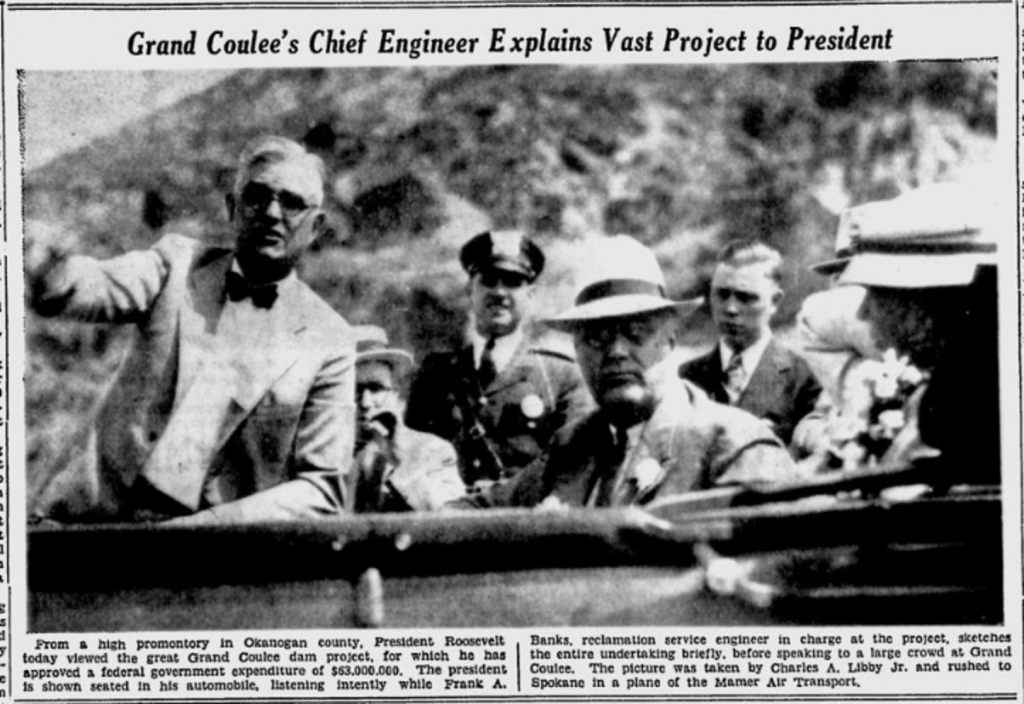On the morning of August 4, 1934, President Franklin Roosevelt had breakfast in his private Great Northern Special railroad car on a siding in Ephrata in east central Washington. After breakfast Roosevelt left in a motorcade to drive to the Grand Coulee damsite.
The president’s irascible Interior Secretary, Harold Ickes, a huge backer of big, costly and transformative infrastructure projects like Grand Coulee was part of the group and he recorded the details in his diary.

“The dam to be built here will take six times as much concrete as will be required at Boulder Dam,” Ickes wrote, referring to the massive dam – now called Hoover Dam – spanning the Colorado River south of Las Vegas. “There are at least a million acres of extremely fertile land which will be able to produce abundant crops if and when they get water from this project.”
Ickes expressed amazement that 20,000 people, many traveling hundreds of miles, gathered at the Grand Coulee construction site – literally the middle of nowhere – to cheer on the prospect of irrigation and energy. These folks knew the desert would bloom. New jobs would be created. Economic opportunity would come to Grant County and the larger region.
Spending money to put people to work building big things was the essence of Roosevelt’s Great Depression fighting New Deal in the Pacific Northwest. The huge dams spanning the lower Columbia and the upper Missouri, among the greatest human built structures in the world, are the most visible monuments to a Democratic president’s infrastructure plans, but the concrete is only a part of the story.
It is not hyperbole to say that FDR’s New Deal built the world we inhabit: Schools in Boise, Parma and a half dozen other places; a golf course in Idaho Falls; post offices in Grangeville, Orofino, Bonners Ferry and Buhl, even the Red Ives Ranger Station up the St. Joe.
The June 1937 issue of Western Construction News took notice of the electric infrastructure under construction in north central Idaho. The Roosevelt Rural Electrification Administration (REA) allotted $75,000 to the Clearwater Valley Light and Power Association in Lewiston “for construction of a generating plant of 800 KW capacity.” Another $400,000 was handed over to “for construction of 300 miles of transmission lines in Idaho and Washington.”
Farm to market roads were improved in Asotin County. Husky Stadium in Seattle was expanded. A high school built in Kennewick, a library in Dayton and $141,000 was spent on municipal sewer improvements in Spokane.

The “Living New Deal” history project has catalogued no less than 114 separate infrastructure projects in Idaho and 259 in Washington that have the roots in Roosevelt’s massive – the critics said socialistic – infrastructure program of the 1930’s.
It’s no accident that Joe Biden, a rare politician with connections to the New Deal generation of builders, has placed a portrait of Roosevelt in the Oval Office and is proposing a New Deal-like $2 trillion infrastructure program. Somewhere Harold Ickes is smiling down on Biden’s determination and no doubt chuckling at the conservative handwringing over an initiative that could prove to be as transformative as when FDR came to Ephrata and celebrated his ambitions.
The conservative push back to Biden’s initiative – too expensive, not really infrastructure, pure old socialism – would be more credible if Republicans had anything to propose or hadn’t squandered four years of the incompetent last administration promising to address infrastructure and failing to do so.
The truth is there is no conservative alternative, no proposal, no suggestion of what might be done to rebuild what has crumbled and build new what is needed. As with so much of the politics of the moment, the conservative alternate is to complain. Mitch McConnell bemoans a “massive tax increase,” which is what Biden is proposing – a long-term tax increase on corporate America, including some of the biggest corporate names in America who pay, well, nothing in taxes.
Twenty-six different companies by one recent study, including Nike, FedEx and Duke Energy, paid zero while reporting a combined income of $77 billion. You might think a guy like Amazon’s Jeff Bezos, struggling by as the world’s richest man on his $177 billion fortune, would be up in arms about Biden’s proposal. He isn’t. Bezos said this week he supports long-term corporate tax increases to fund the infrastructure effort.
A key piece of Biden’s proposal would finally see serious action on broadband in rural America, an absolutely essential component of economic revitalization in much of the West. Expanding high speed internet access in rural America was not that long ago a Republican talking point, but now that Biden has actually teed up a real proposal, congressional conservatives have lost their enthusiasm.
Governor Brad Little apparently didn’t get the GOP memo since he said recently, as National Public Radio reported, that infrastructure, particularly rural infrastructure, is a genuine priority. “As we work on our quest for more broadband and better roads,” Little said, “that means that that growth can be dispersed out into areas, particularly areas that have had a dislocation, that have lost a major employer.”
That sounds a lot like FDR in eastern Washington in 1934, and also like the making of an economic strategy that both parties should get behind.
The political debate over whether and to what extent to involve the government in rebuilding a battered economy certainly didn’t begin with a deadly pandemic that has crushed job growth and decimated many small businesses. But the current posture on the right – ignoring the scope of the economic problem, while belittling every solution and hoping the neglect reaps political rewards – is an old tune, the kind of cynicism Roosevelt’s critics wallowed in the 1930’s.
There are signs that American business isn’t falling in lock step with McConnell’s economic nihilism, but rather embracing the 21st Century infrastructure proposal for what it is: a launching pad for a new American economy. Republicans, meanwhile, promise a fight to end, and to hell with the economy and the folks who would benefit.
Yet public opinion is on his side, so Biden would be well advised to parrot Roosevelt’s famous statement about his do-nothing opponents in 1936. “They are unanimous in their hate for me — and I welcome their hatred,” Roosevelt said, and then won a landslide re-election.
For their part, Republicans would be smart – not likely – to heed the advice of Jesse Jones, a hardheaded Texas businessman who was a top aide to FDR. “Be smart for once,” Jones begged the conservative critics of those earlier days. “Go partners with the President in the recovery program without stint.”
—–0—–
Additional Reading:
Some other suggestions for items worthy of your time…
Ozzie and Harriett Went Off the Air in the 1960’s
I was pleased to have a column earlier this week in the new, non-profit news site Idaho Capital Sun. I wrote about Idaho’s long struggle to deal with a no-brainer, early childhood education:
“An enduring debate for the last half century in Idaho has been the question of establishing, sustaining and attempting to expand educational opportunities for very young children. Idaho’s systematic failure to develop a policy for early childhood education is a key factor – perhaps the key factor – in why the state habitually ranks so low in educational achievement.”
In Sickness and Health
A lot of buzz about a new book with an inside view of a hospital struggling to survive in rural America.

“The first remarkable thing about Brian Alexander’s new book, The Hospital, is that he managed to pull off an exception to this seeming iron law of U.S. health care. He never explains exactly how, but in early 2018 he persuaded the CEO and board of a small, community hospital in rural Bryan, Ohio, to give him fly-on-the-wall access to their struggling institution—and complete freedom to write up what he witnessed. “
The Washington Monthly has a review:
The filibuster can be conquered: I know — I helped do it
And I really enjoyed this piece by John G. Stewart, a former top aide to Minnesota Senator Hubert Humphrey, on how the filibuster was beaten to pass the Civil Rights Act in 1964.
“The recounting of what happened in 1964 points the way in 2021.
“Force the opposition to hold the floor and talk. No more premature “test votes.” No weakening amendments prior to cloture. Get organized by assigning senators to monitor the floor and be ready to defeat likely quorum calls. Coordinate closely with outside support groups and the media. Stay on the offensive.”
Required reading to understand the current battle over Senate rules.
Thanks for following along. Be safe out there.
